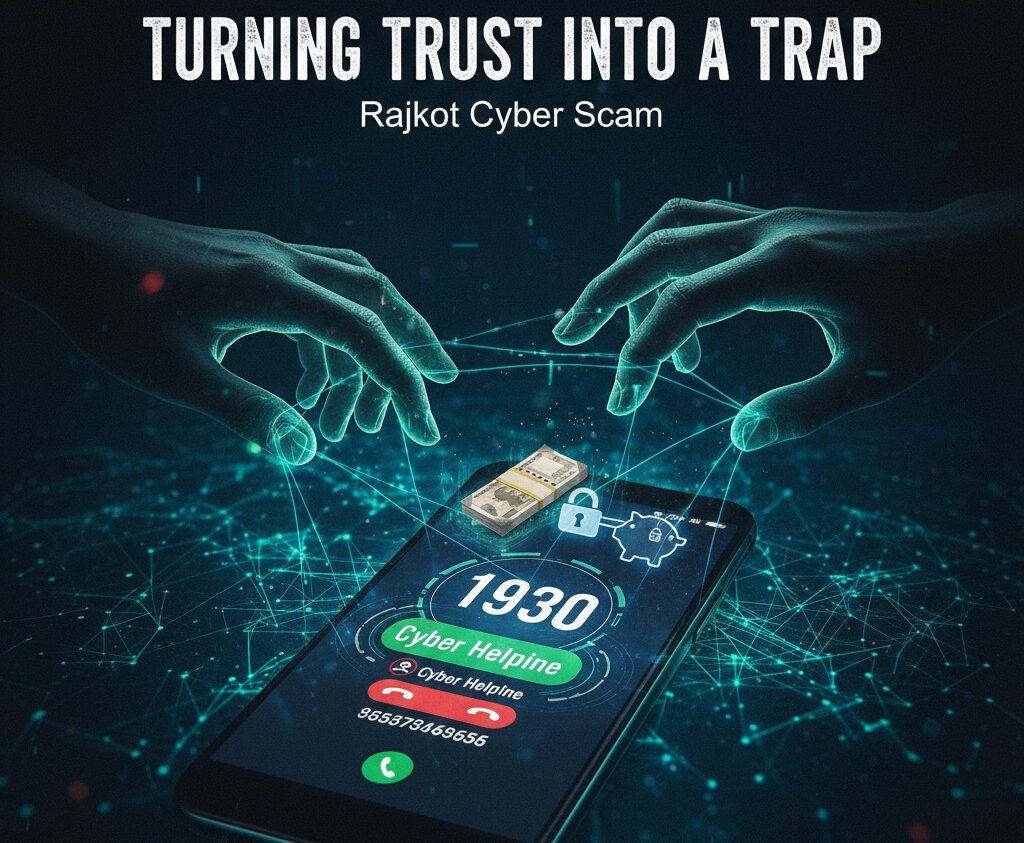Rajkot — What began as a modest ₹3,000 deposit into a dormant bank account spiraled into an elaborate scam that now has Gujarat’s cybercrime police confronting a troubling new phenomenon: criminals hijacking the 1930 national cyber helpline to defraud citizens under the guise of protecting them.
The victim, Chetan Kapuriya, a brass parts trader from Jamnagar, found his account—holding ₹1.44 crore—suddenly frozen on October 17 after receiving the unexplained deposit. Two days later, a call came from an international number.
The caller, identifying himself as Darshit Kagdada, told Kapuriya that his account had been flagged for a suspicious transaction and frozen by “Nalasopara Police.” Then came the demand: pay to have the account “released,” or face being falsely implicated in a case with the Enforcement Directorate (ED).
Realizing the claim was a ruse, Kapuriya reported the matter to police. By then, however, the scam’s ingenuity had already rattled investigators.
“They used the government helpline as a weapon,” said Inspector I. A. Ghasura of the Jamnagar Cybercrime Police Station. “The system meant to help victims was turned against them.”
Turning Trust Into a Trap
The 1930 helpline, launched as a national mechanism for rapid cyberfraud response, allows victims to report suspicious transactions immediately so that banks can freeze compromised accounts. But in this case, scammers pre-emptively filed a false complaint, using a ₹3,000 transfer to trigger an automatic freeze on Kapuriya’s account.
The First Firm to Assess Your DFIR Capability Maturity and Provide DFIR as a Service (DFIRaaS)
Once the account was locked, they leveraged fear and bureaucratic opacity to pressure the victim into paying for its “release.”
Investigators say the fraudsters had detailed knowledge of the system’s back-end procedures, including how bank freezes are coordinated with state cybercrime portals. That technical sophistication, police say, hints at an organized network with access to insider information or training in financial redress mechanisms.
“This wasn’t random phishing,” said a senior cyber official familiar with the probe. “It’s procedural mimicry — they’re learning how to impersonate the state itself.”
The Arrest and the Expanding Web
Police arrested Kagdada, a Jamnagar resident, who confessed to obtaining Kapuriya’s financial details from a contact in Ahmedabad. Authorities are now tracking multiple suspects believed to be part of the same ring, including individuals in Maharashtra who may have helped execute the fake complaint through the helpline system.
The case has exposed how fragile digital governance frameworks can become when fraudsters exploit procedural loopholes rather than technological weaknesses.
Kagdada’s method — depositing a small sum to trigger scrutiny, then filing a fraudulent report — represents a hybrid model of cybercrime, blending financial manipulation with social engineering and bureaucratic exploitation.
Cybercrime officers warn that such tactics could multiply if safeguards around the 1930 portal are not fortified with stronger authentication and cross-verification mechanisms.
A National Helpline at a Crossroads
Since its launch, the 1930 helpline has helped freeze and recover hundreds of crores in stolen funds. But as fraudsters study the system, investigators fear it may become a battleground between citizen protection and systemic abuse.
In Gujarat alone, police say over 1.2 lakh cyber complaints were filed last year, many handled through the portal. Yet for every rupee recovered, others remain trapped in procedural delays — a vulnerability scammers now appear to exploit.
“We’re seeing criminals shift from technology hacks to process hacks,” said a retired cyber law expert. “When trust in the state’s response mechanisms erodes, it’s not just individuals who lose — it’s the credibility of governance itself.”
For Kapuriya, whose funds remain under forensic review, the incident is more than a financial disruption — it’s a cautionary tale of how even the most well-intentioned digital systems can be weaponized in the wrong hands.


